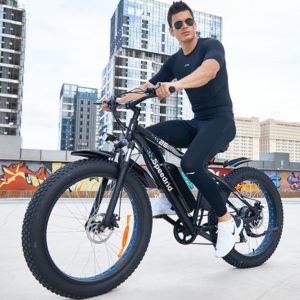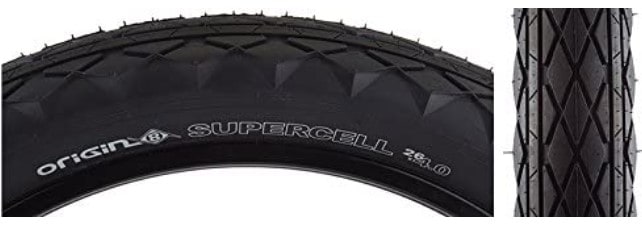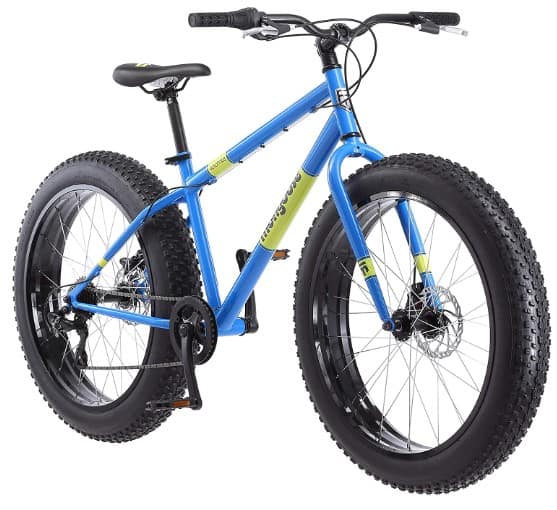Most people ride fat bikes off-road, taking on the snow, gravel, rocks, and dirt. However, very few people consider them for paved roads. So, can you ride a fat tire bike on pavement?
Fat bikes come with all-terrain fat tires. So, they can take on the pavement and other surfaces. But given that the tires are broad, heavy, and knobbier, fat bikes are slower on-road.
Overall, if you want a bike that you can ride on pavement and non-paved surfaces, you cannot discount fat bikes.
The bikes may not be the lightest or the fastest, but they have the robustness to conquer all terrains in all weather.

But Can You Ride A Fat Tire Bike On Pavement?
As I mentioned, fat bike tires are an all-terrain choice. As a result, they can take on pavements and other surfaces.
Yes, these bikes are not the speediest on-road, but they allow you to ride when it snows or rains, something you cannot do with other bikes.
If the weather is unpredictable and you have to commute with a bicycle, a fat tire bike makes sense. Remarkably, you can ride it under the hot sun and during a downpour.
I’ll explain how you can make a fat bike faster on-road to get the most out of it. But first, let’s look at the things that make fat bikes slower on paved roads.
Why Fat Tire Bikes Are Slow on Pavement
Essentially, fat tire bikes are slow on pavement because of these reasons:
- The tires are broader and knobbier
Compared to road bike tires which are skinnier, fat bike tires are extra wide. Fat tires are at least twice as wide as road bike tires. As a result, fat tires don’t roll smoothly or faster.
Their tires are also knobbier, meaning they have more grip to give them more traction.
The problem with their profile is that it improves their rolling resistance. So, they become slower on-road.
- Fat tire bikes are heavier
Fat bikes have thick and heavier wheels. Plus, their frames are equally big and heavy to support the massive wheels. So, both the wheels and frames make the bikes heavier and, therefore, slower.
Tips for a Fast Fat Tire Bike on Pavement
While a fat tire bike is generally slower, here are a few things you can do to move faster:
a) Add more tire pressure
Fat bike tires run on low pressure of up to 20 psi to increase tire-to-road contact and reduce bumps. The problem with such low tire pressure is that it slows you down.
So, how about you improve the pressure slightly? Doing so can reduce ground-to-tire contact to allow you to ride much faster.
You can do 40-60 psi to reduce the tires’ rolling resistance.
b) Switch to non-studded fat tires
Generally, riding a fat bike on the road is funnier if the tires roll with less resistance. That’s only possible when the tires are non-studded.
Though most fast bikes come with studded tires, you don’t have to use them, especially when you want to go faster. Remember, while the studs improve your off-road traction, they slow you down on-road.
My advice is that you should have two sets of tires; studded and non-studded. If so, you can use studded when it snows or rains and non-studded when the weather is okay.
Check out the Origin8 Supercell Fat Bike Tires if you want the widest and fast-rolling tires for your fat tires.

c) Consider an aluminum frame
Most fat bikes come in steel frames, which make them heavier. However, some come in aluminum frames, thus lighter.
So, if you are looking to move faster, get an aluminum-framed fat bike over a steel option.
d) Invest in an electric fat bike
Let’s face it; an average speed of 20mph is pretty decent for a fat bike.
Well, that’s what you get from an electric fat bike. So, if you are looking to go faster on a fat bike on pavement, consider a motorized option.
An e-bike like the ECOTRIC Electric Fat Tire Bike 500W averages a top speed of 20mphs but can hit 23mph under perfect conditions.
Mark you; this e-bike can bear up to 260 pounds while moving that fast.
When Is Riding Fat Tire Bikes On Pavement Most Preferred?
You probably are asking, ‘if a fat bike is slow on pavement, should I get it?’
My answer is yes, and here are situations where a fat bike is best preferred for pavement cycling:
- When it rains or snows
The fact that fat bike tires are knobbier means that they won’t slide on wet surfaces. Their knobby profile offers them massive grip when riding on wet roads safely.
Unlike typical road tires, which are thinner and smoother, fat tires are more expansive and grippy, thus great for wet surfaces.
For that reason, you can ride the bikes on snow roads and when there is a heavy downpour.
Check out the ever-impressive Mongoose Dolomite Fat Bike (View on Amazon) to understand what I mean by all-terrain tires.

- When commuting between paved and unpaved roads
While a fat bike may be slower than a road bike on-road and even slower than a standard MTB off-road, it gives you the convenience that neither of the two offers.
I’m talking about the freedom to ride on all surfaces.
A mountain bike can go over pavements and non-paved surfaces, but it’s not reliable on wet surfaces, especially the snow.
A fat bike, in contrast, can take on terrains that a standard mountain bike would ordinarily not take. That’s what you get from many other fat bikes.
What Are the Advantages of Fat Bikes On Pavement?
Here are the advantages that fat bikes enjoy on the pavement:
- Riding comfort
The reason why fat bikes are comfortable to ride is because of their supersize tires. They spread your weight on the bike frame, absorb shock, and offer you extra stability.
As a result, the tires improve your riding comfort. Since they run on low pressure, they absorb the bumps to allow you to ride more smoothly.
- Perfect in all-weather
Fat bike tires don’t just roll over everything on their path. They are also equipped for all weather conditions.
Whether it’s the wet winter or the dry summer, you can comfortably ride a fat bike.
Just check out the Mongoose Malus Fat Bike (View on Amazon) to understand what I’m saying.
Its knobbier tires can grind over snow and other wet surfaces, making the bike an ultimate all-season pick.

- Better balance
A fat bike’s slow speed is a blessing in disguise. It allows you to ride more cautiously and enjoy more balance, thus safer.
They also enjoy a lot of traction, thanks to their knobby tires.
FAQs
1. Are Fat Tire Bikes Good On Pavement?
Fat tire bikes can ride over pavements and other surfaces. However, they are slower on paved surfaces because their wide knobby tires suffer a lot of rolling resistance.
Also, these bikes are heavier than most, and that makes them slower.
2. Can You Ride A Fat Bike On The Road?
You can ride a fat bike on the road and anywhere you wish to explore on a two-wheel. Note, however, that a fat bike cannot go as fast as a road bike as it’s heavier, and its wide tires face a lot of rolling resistance.
3. What Is The Point Of A Fat Tire Bike?
The point of a fat tire bike is to have a bicycle that can take all terrains regardless of the weather. These bikes can go over rocks, mountain trails, soft sand, mud roads, and urban roads.
As a result, fat bikes are best for commuting, trail adventures, running errands, exercising, and just about anything.
4. Is A Fat Tire Bike Hard To Ride?
Fat tire bikes are not hard to ride, at least not as much as most bikes. Their massive wheels offer you so much stability and grinding power while their knobbier tires absorb shock.
For those reasons, beginners find them easier to ride and more comfortable.
5. Are Fat Bikes Worth It?
If you intend to commute, exercise, run errands or explore the unpaved neighborhood, a fat bike is worth it. The bike’s supersize tires absorb bumps and offer you maximum grip and balance.
Plus, their massive tires can go through the trickiest challenges, such as rocks, forests, thick mud, soft sand, and even snow.
6. Why Are Fat Tire Bikes So Expensive?
Most fat tire bikes are expensive because of their expensive components, more so their rechargeable batteries and high-speed motors. Additionally, their frames, wheels, and other features are costly to assemble.
7. How Fast Do Fat Bikes Go?
The average electric fat bike can go at a top speed of 20mph, with a few options hitting 22-25mph. However, note that non-electric fat bikes are much slower as their speed depends on your pedaling power.
In conclusion, can you ride a fat tire bike on pavement?
From our discussion, you can ride a fat bike on any surface, including paved roads. Note, however, that you’ll sacrifice speed for stability, comfort, and safety.
Frequently Asked Questions
How long do fat tires tend to last on pavement?
Given the high quality of fat tires, you can expect them to last between 2,500 to 3,000 miles, assuming they’re used in normal conditions. As an avid biker myself, I view investing in quality fat tires as a crucial part of securing my riding safety and extending my riding season, which, if you’re anything like me, you’d love to do. One thing I’ve learned from years of biking is that like any investment, you want to ensure that it provides you with long-term value, and a good pair of fat tires is no exception. The typical lifespan of a fat tire under normal use ranges from 2,500 to 3,000 miles.
What’s the appropriate air pressure for a fat tire bike when riding on pavement?
There are many factors that come into play when determining the right tire pressure for a fat bike on the pavement, a primary one being the rider’s weight, and the width of the tire. As a rule of thumb, and speaking from personal experience as a fat bike rider, a tire pressure between 20 and 30 PSI works well for most pavement conditions. I’ve found that this range provides the right balance between comfort and efficiency, giving the tires enough cushion and durability to handle the hard surface. The recommended tire pressure for a fat bike on pavement generally ranges between 20 and 30 PSI.
Is cycling with fat tires more difficult?
From my biking adventures, I can confirm that pedaling a fat bike can be a bit more challenging due to its extra weight. Particularly when tackling uphill slopes, the additional weight becomes more noticeable. The broad tires also add to the rolling resistance of the bike, which can limit the speed you can reach. However, the increased traction and stability that fat tires offer can make such a ride an intriguing adventure. Yes, the added weight and increased rolling resistance can make riding a fat bike more challenging, especially uphill on the pavement.
Are fat bikes suitable for road riding?
Fat bikes shine on slippery and loose terrains due to their large, low-pressure tires. However, this same feature can make them less efficient on pavement rides when compared to road bikes fitted with slick 25-32mm tires. As someone who has used both types of bikes, I can tell you that while you might not set any speed records, the unique experience of using a fat bike on pavement is its own reward. Fat bikes can handle road rides, but they might be slower compared to road bikes due to the higher rolling resistance of their tires.